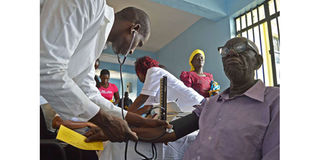High cost of health services may derail Uhuru's grand plan

A medic attends to a patient.
What you need to know:
- The committee has urged Ms Kariuki to ensure that the country reverts to the 2006 pricing guidelines abandoned two years ago.
- Ms Kariuki said that an action plan has been drawn up and governance structures put in place to ensure that drug prices are standardised.
- Kenya has an average of 38 health workers for every 10,000, but the workers are not fairly equitably distributed.
The universal health coverage (UHC) programme, to be launched on December 13, is facing several challenges, with stakeholders warning that the high cost of drugs and medical care, lack of human resources, and drug shortages could derail one of the pillars of President Uhuru Kenyatta’s ‘Big Four’ agenda.
The Linda Mama Programme and disbursement of funds to the elderly will also be restructured.
Health Cabinet Secretary Sicily Kariuki said that the two will be merged in the four piloting counties, and will be handled by the UHC pool to ensure efficiency, since some of the funds to be used in the health project will be drawn from previously existing pools.
“A pregnant woman who would otherwise use Linda Mama is the same person who will require to access other facilities and services in the pilot counties," she said. "We are reforming this and will be dealing with only one central pool.”
COST
Previously, the Linda Mama programme in the counties was handled by the National Health Insurance Fund (NHIF), which is being investigated following claims that money intended to cover expectant mothers was used misused.
On drugs, National Assembly Committee on Health Chairperson Sabina Chege called on the government to ensure that the prices of medicines and cost of medical services in the counties are regulated before the programme is launched in Kisumu next Thursday.
“The cost of medical services is too high for the ordinary mwananchi. We sat down as a committee and looked at the cost of healthcare; from what the private doctors charge to the cost of drugs, and compared with other countries, ours are extraordinarily high,” she said.
She was speaking during a forum convened by a parliamentary committee on the UHC attended by Ms Kariuki, the Kenya Medical Supplies Authority, the NHIF and other health stakeholders.
“As we look towards the achievement of UHC, we must factor in the issue of affordability," Ms Chege said.
REVIEW
Currently, the cost of treatment depends on where you are, and whether you visit a private or public facility.
The committee has urged Ms Kariuki to ensure that the country reverts to the 2006 pricing guidelines abandoned two years ago.
They want the Medical Practitioners and Dentists Rules 2016 replaced with the second edition of the Professional Fees Rules and Guidelines 2006, which prescribe cheaper rates for various medical services.
“The ministry, KMPDB, and the Pharmacy and Poisons Board must review, within six months, reasonable professional fees rules and guidelines, regulations and must ensure that the cost of medical services and drugs are in tandem with the UHC agenda. This should be done with proper consultation and public participation,” the committee said.
The 2016 guidelines came into force on July 22, 2016, through a legal notice published by then Cabinet Secretary Cleopa Mailu.
FEES
Reinstating the 2006 guidelines will see the fees charged by medical practitioners slashed by up to 50 percent, starting with the first visit consultation fee for general practitioners, which will drop to a maximum of Sh2,500 from Sh5,000.
Patients on follow-up visits will be charged not more than Sh1,500.
Under the guidelines, specialists cannot charge more than Sh4,000 for consultation, down from the current maximum of Sh7,500.
“We don’t want to know who controls what resources. What we are fighting for is to ensure that Kenyans are given the best before the launch of UHC agenda,” Ms Chege said.
Ms Kariuki concurred, saying the cost of treatment and drugs will be addressed, adding that an action plan has been drawn up, and governance structures put in place to ensure that drug prices are standardised.
SHORTAGE
“For us to be able to look back and say that UHC is being rolled out, we must look at the cost of medicines or equipment. The cost of drugs and other equipment are inflated. We need to agree that drugs do not go beyond a certain price to be able to achieve this UHC agenda,” Ms Kariuki said.
“Conversation and monitoring are taking place and as we move to four pilot counties, we have agreed on a standardised price for the drugs going to the those counties. We will be checking to ensure that drugs are not overpriced,” she said.
Another challenge is the lack of, or shortage, specialists in many health facilities.
Kenya has an average of 38 health workers for every 10,000, but the workers are not fairly equitably distributed.
There are 170,000 registered health workers, with 2,089 specialist doctors. More than 50 percent are based in Nairobi, according to the Kenya Health Workforce Report: The Status of Healthcare Professionals in Kenya, 2015 prepared by the Ministry of Health and Emory University in the United States.
In 2015, there were 5,660 medical doctors, of whom 387 were gynaecologists, 338 experts in general surgery, and 196 internal medicine experts.



